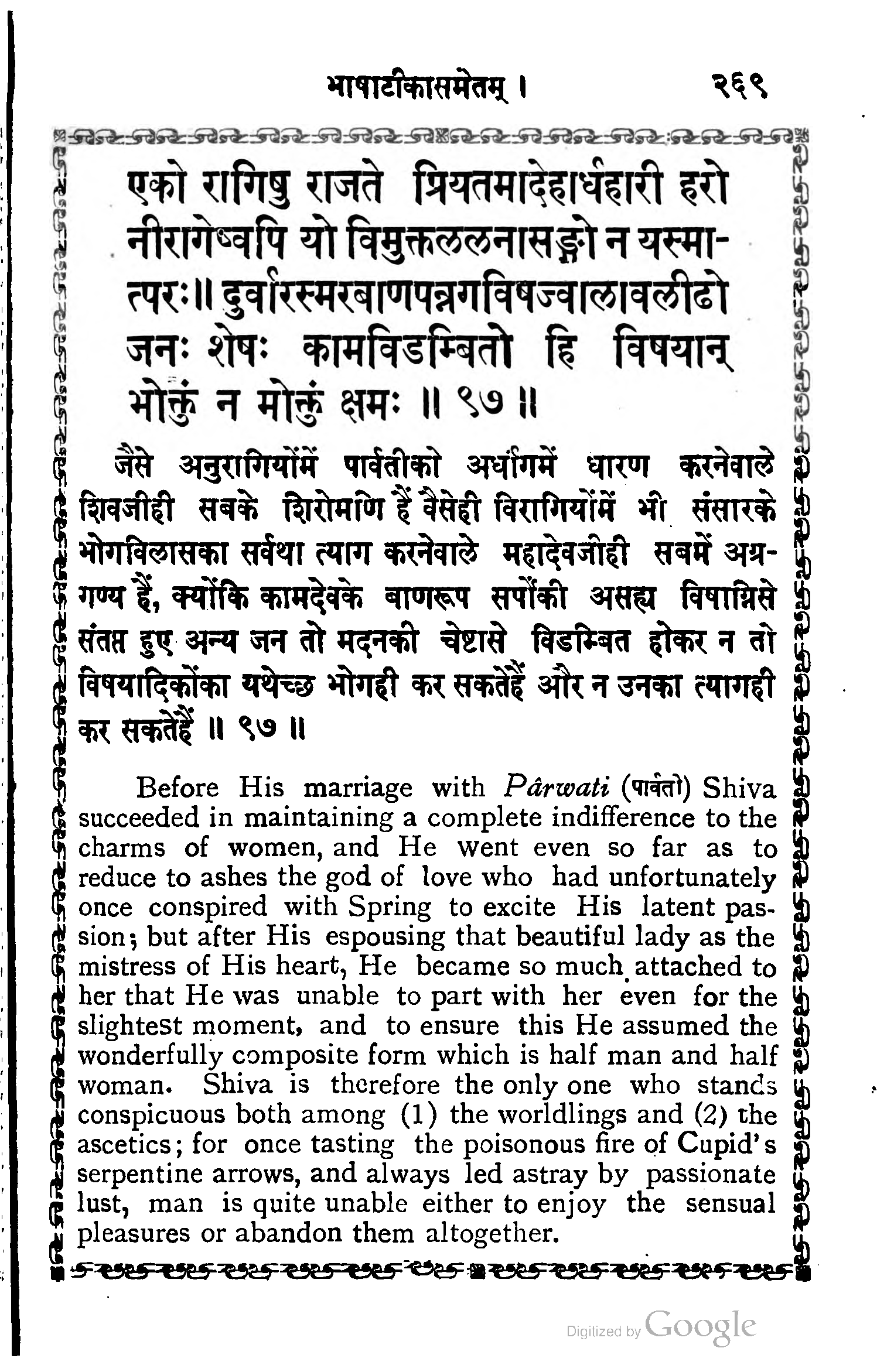Tawney
Mādhavānanda
Telang
verse

Text (not proofread)
एको रागिषु राज़ते प्रियतमादेहार्धहारी हरो
नीरागेषु जनो विमुक्तललनासङ्गो न यस्मात्परः ।
दुर्वारस्मरबाणपन्नगविषण्याविद्धमुग्धो जनः
शेषः कामविडम्बिताल विषयान्भोक्तुं न मोकुं क्षमः ॥ ८ ॥
endnote

Text (not proofread)
St. VIII . & c . alludes to the idea that S'iva and Pâr
vati form a single body , one half of which is male and the other
half female . TFTC : = to whom there is no superior . The two
lines mean that S'iva though he is so far under the dominion
of Love as to have his wife as one half of himself , is also the
first as to withstanding love . The fourth line should not have .
two negatives . It means " the rest are able only to enjoy not
to abandon . " As it stands , it may mean , " The rest can neither
enjoy ( i . e . properly ) nor abandon " & c . - S'árdúlavikridita .
Kosambi
verse


Text (not proofread)
एको रागिषु राजते प्रियतमादेहार्घहारी हरो
नीरागेषु जिनो विमुक्तललनासङ्गो न यस्मात् परः ।
दुर्वारस्मरबाणपन्नगविषव्यासमुग्धो जनः
शेषः कामविडम्बितो हि विषयान् भोक्तुं न मोक्तुं क्षमः || २२ ||
footnote


Text (not proofread)
224 { Ś , V } Om in W and C ( but C2 $ 80 ) . Coming a ) F1 m.v. राजिषु
( for रागिषु ) . D G + जायते ; G1 M 1.3 विश्रुतः ( for राजते ) . F1 ~ 3 X G 3 ( orig . ) .
M + 5 ' धारी ; F5 Fs lacuna lacuna ; ; Ji Ji ' दायी ( for ० हारी ) . P – 0 ) D यते ; Es ( by corr . ) F1.2.4 ( orig . )
J2 X Y T_G ± 5 M4 जनो वि- ; F3 m.v. [ अ ] जितो वि- ; Fs पुनर्वि ; G1 M1-8,8 स एव
( for जिनो वि - ) . F1 - वनिता ( for - ललना- ) . ( ( 4 संगोम्ति ; M + 5 संगोपि ( for -सङ्गो न ) .
D यस्यात्परः ; F2 यस्मात्पुरः ; F + J1.2t G1 - 3 यस्यापर ; J20 Y7 Ms यस्याः परः ( Ms " रं ) ; Y1
तस्यापरः ; G + M + 5 यः सोपर : ( for यस्मात्परः ) . F3 Ic Jit नीरागो जि ( Jit ज ) न एक एव भुवने
( Jit जननो ) संगो न यस्या ( F3 स्मात् ) पर :. c ) Fs - पन्नगाधिक ; I -घस्मरोरग ( for
- बाणपन्नग - ) . AFX -व्यासक्त ; Bo.1.6 F2 - व्यासक्ति ; Y2.3 . TG1 . 4 M3.5 व्याविद्ध
( for - व्यासङ्ग - ) . A E1.5 Y -मूढो ; Fs . it . v . -दग्धो ; Ji -दग्धा ; X - मध्यो ; ( G1 M3 - बोधो ;
G2 मूर्ती ; G3.5 - मुक्तो ( for मुग्धो ) . F3 Jat जनाः ; Get जिनः . d ) F5 Jat शेषा :; Ys
कान्ता - ( for शेष :) . B1 स्त्रीपु ( for काम ) . 13 - विजंबितो ; B1- विमोहितो ; E3 . 4 विटंबितो ;
F3.0 X -विडंबिनो ; Y1.4–6 . 3 T G_M1-3 -विडंबितानू ; M1.5 विडंबनान् . DJ1 X Y2.7
[ 5 ] पि ; E2 [ .s ] खि ; I J2 Y1.8–6 . 4 T GM न ( for हि ) . J1 भोक्तुं विमुक्तं ; X M. त्यक्तुं न
भोक्तुं ; Y1 मोक्तुं न भोकुं . Fs J12t G + क्षमाः
BIS . 1436 ( 3842 ) Bhartr . lith ed . II . 1. 77. Schiefner and Weber P. 22 .
Subhāsh . 142 ; SM . 1463 ; SN . 413 ; SSD . 4. f . 8a ; SSV . 1446 ; SLP . 5. 13 ( Bh . ) .

